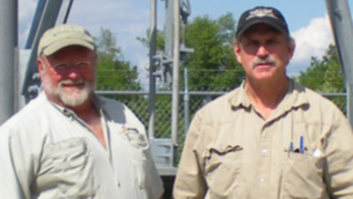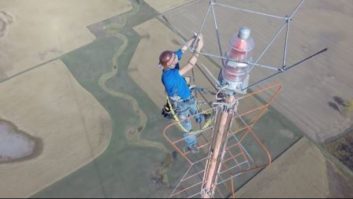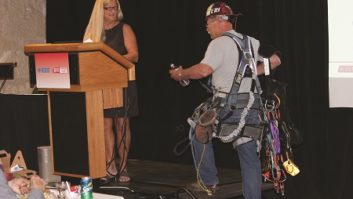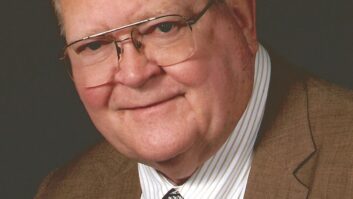CHANDLER, Ind. Lots of people can say they’ve been to the top of the Empire State Building, but not many have been where Tom Silliman has been, clinging to a metal framework and looking down at the art-deco peak, once intended as a dirigible mooring mast, that now anchors a cluster of FM and TV antennas for New York City.
Tom Silliman FactsBorn: March 15, 1945
Personal: Divorced, two daughters, 23 and 26 years old.
Located: Newburgh, Ind.
Education: Bachelor’s and Master’s degrees in Electrical Engineering, Cornell University, 1969 and 1970, respectively.
Professional: Registered as a professional engineer in Indiana, Minnesota and Maryland.
Even though the 56-year-old Silliman is CEO and majority stockholder of Electronics Research Inc., a manufacturer of towers, FM antennas, and combiners, he still climbs towers on the job – against the advice of some of his friends.
In recent months, his work has put him where few in the radio supply business go: on national television and into the pages of the New York Times.
“I have no intention of quitting climbing,” Silliman said emphatically. While he cannot go out drinking the night before a climb, as he says he did in his 20s,he believes he remains fit because he has adapted his life to the needs of his work as he ages.
Spartan life
“In my 30s, I started a weight-training program. I’ll go to the gym tonight and I’ll run about five miles. It’ll take me about 45 minutes. My pulse rate will go to about 132. I live a very Spartan life.”
Electronics Research Inc. was established in Evansville, Ind. in 1943 to perfect the radio systems used in World War II aircraft.
The middle-America location was no accident. The city was out of reach of enemy aircraft, and the Ohio River was too shallow for submarines.
Silliman’s father, Robert Silliman, worked at the Radio Research Laboratory in Boston, and flew to Evansville several times during the war to test radio gear at ERI.
Robert Silliman died in February of this year at age 87.
After the war, the elder Silliman conducted research and development as a consultant for ERI. When ERI’s owner died in the late 1950s and the company began to falter, one of its major clients, Collins Radio Co., hired Robert Silliman to study why antennas it bought from ERI were not performing up to par.
Silliman concluded that the late owner’s widow and her accountant lacked the expertise to manage the technical enterprise. Not long after, ERI collapsed financially, although it did not declare bankruptcy. The entire staff was laid off. Collins asked Silliman to take over ERI, which he did in partnership with Chester Newcomb, an ERI field technician from its beginnings in the war. Together they bought the company’s assets and reorganized it.
Under Newcomb and Robert Silliman, the company flourished, according to his son Tom, developing the Vertical 300 dipole and several circular polarized antennas in the 1960s.
Tom Silliman joined the firm after receiving his Bachelor’s degree in Electrical Engineering from Cornell University in 1969.
“Chester and I would go out and I started doing the field service and then Chester would climb for me and that’s about all he did,” Silliman said. He took a leave of absence for one term in 1970 to finish his Master’s degree in Electrical Engineering degree at Cornell.
With that degree in hand, he came back to serve as project engineer for ERI’s build-out of an antenna on top of One Shell Plaza in Houston.
“That was a 12-layer, three (-sided) FM panel antenna that had first- and second-null fill and beam tilt,” Silliman said with evident pride.
“It was quite a design. It eventually had eight stations operating at 100 kilowatts ERP from it.” Silliman said, at that time, it was the highest-power FM system in the country.
Filter redesign
Many other projects followed through the 1970s, until ERI stopped taking new work for a year in the early ’80s to concentrate on redesigning its filters. The new designs paid off in better performance and in new jobs, such as that on Boston’s Prudential Building, according to Silliman.
In 1992, Silliman led the team that installed new antennas atop the Empire State Building. While not ERI’s largest antenna complex, Silliman says it was the company’s most extensive job, involving the design and installation of not just antennas but also transmitter rooms, cable chases and an access alarm system.
During this 18-month job, he and his team replaced antennas further down the structure that exceeded radiation standards for people on the top floors of the building.
“That is probably the most incredible thing I have ever been involved in.” Silliman said. “I’m not going to say it’s the most incredible thing I’ve ever done, because I didn’t really do it (alone). I did it as part of a team, an incredible team of manufacturing and business management and engineering.”
It’s hard to look at a photograph of Silliman clinging to a mast 1,500 feet above street level without thinking of the risk involved.
His high-altitude climbing has attracted the attention of national media. In April, ABC’s “20/20” profiled him as one of its “People Working on the Edge.” The New York Times covered one of his trips to the top of the Empire State Building in January under the title, “Where Is King Kong When a Bulb Goes Out?”
Silliman says he’ll also be featured in an upcoming segment of the “Ripley’s Believe or Not” program.
Silliman insists the national exposure doesn’t faze him.
“Lots of times people who live ordinary lives think that anybody who works in broadcasting is unique,” he said. Silliman, who once climbed towers wearing a leather lineman’s belt and simple clips that could “roll out” and detach from the line, now boasts that his company uses only state-of-the-art climbing gear.
Engineers ride only steel cables, wearing synthetic belts that include shoulder and leg straps to hold a climber if he becomes inverted. New “ascenders” allow a climber to go up the line, but lock and hold the climber in place should he lose his grip.
ERI has never lost a tower climber on the job, said Silliman.
He and his staff will get plenty of opportunities to climb in the next few years, with the advent of digital television and the promise of in-band, on-channel digital audio broadcasting. ERI’s FM antennas feature a wide bandwidth – good news for stations that are forced to take down their current antennas to make room on a tower for a new digital TV system.
Side-mounted rototiller
“Because our side-mount product is so broad, we’ve managed to put two and three stations regularly into a side-mounted rototiller, and keep stations located at the same site.” Silliman said. “All of a sudden, two antennas and feed lines go down, and two DTVs go up, and everybody’s happy.”
In some ways, co-locating stations has been made easier by the consolidation of the radio industry. FM stations that are forced to use the same antenna now often are owned by the same company, eliminating the politics between competitors that Silliman saw in previous years.
ERI’s engineers are preparing for the IBOC era, designing combiners to merge the outputs of digital and analog transmitters onto a single transmission line. ERI also is mulling over designs for dual-input antennas that do the combining right on the tower.
“If you do that, you can eliminate a lot of that loss (from the combiner),” Silliman said. “But then you have to provide an extra feed line on the tower, and now we have weight and wind load and installation cost, and so on. It’s really going to be a question of where you spend the money: whether you spend it on lost energy or whether you spend it on new hardware.”
When asked about another potential future antenna technology, the Crossed-Field and EH Antennas, Silliman said he does not believe the claims that thesecompact AM antenna designs can match the performance of a traditional tower.
Silliman studied the theory behind the CFA and EH antenna two years ago, and participated in a panel on these antennas at the Institute of Electrical and Electronic Engineers last year. He observed as the CFA and EH proponents delivered a paper supporting their concept at NAB2000.
What does Silliman think of their claims? “Total snake oil,” “bunk,” and “a marvelous scam” are the more polite terms he uses.
“I went about it using the electromagnetic field analysis with Maxwell’s fundamental five equations. I re-read all my texts on that, and as I applied it, I realized that the whole argument in the (CFA) patent was totally false. I couldn’t believe this crap.”
Most of ERI’s business is comprised of selling and installing new systems. The division that evaluates existing structures accounts for roughly 10 percent of ERI’s income, he said.
ERI has had some overseas sales, such as in India, Europe and the Caribbean, but U.S. sales make up the bulk of the company’s work, he said.
Silliman doesn’t mince words about the future of ERI. Despite occasional rumors to the contrary, he said the company is not for sale. He owns 60 percent of the stock, and he intends to keep it. Since the other 40 percent belongs to ERI’s 150 employees through their retirement plan, selling the firm would be complicated.
“We actually did a very thorough study of what it require to sell our company last year, and we were advised that we shouldn’t be looking to sell right now. Our employees aren’t really interested in selling at the moment, nor are we in negotiations with anyone for acquisition,” Silliman said.
Besides, if he sold the company, he might have to hang up his lineman’s belt for good.
“I have a very strange job. As a CEO of a company, I live a very unusual life. If I worked for anybody else I doubt if they’d let me do what I want to do, even though I think I’m pretty good at what I do.
“What I do does expose me to some danger, and I know a lot of people in chat rooms in the last year have mentioned my name and said that I shouldn’t do some of the things that I do. But I like to do them, and I’m good at that.”












